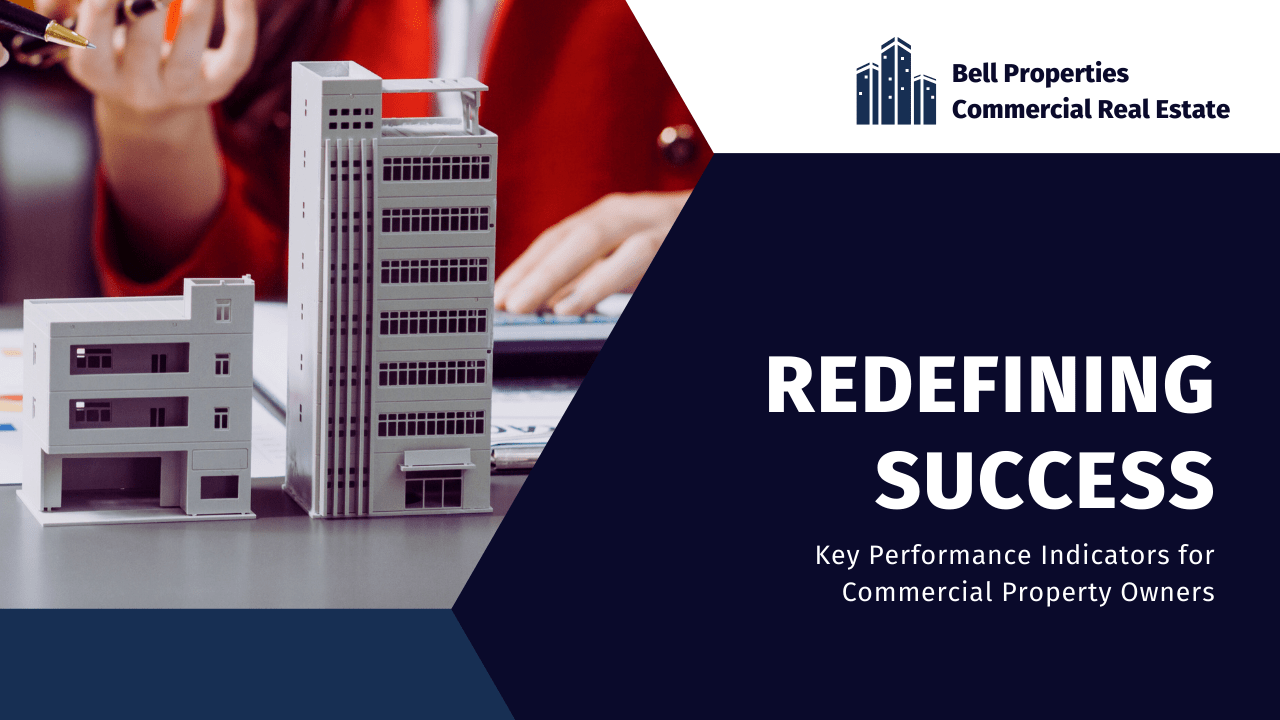We’re talking about Key Performance Indicators (KPIs) today, and that’s a phrase that you should be familiar with as a commercial real estate investor in Los Angeles. It’s nearly impossible to know whether you’re succeeding unless you’re measuring that success in meaningful ways.
As we think about measurement tools and analytics in the ever-shifting world of commercial real estate (CRE), we know that defining and measuring success extends far beyond the conventional benchmarks of profitability and occupancy rates. We now have the tools to dig a little deeper and analyze data that’s more specific to what we’re trying to accomplish.
Today’s most successful Southern California commercial property owners and investors understand that a range of key performance indicators must be consistently tracked and analyzed to truly gauge their properties' performance and long-term viability. By taking a comprehensive approach, you’ll not only align with strategic investment goals, but also adapt to the evolving market trends and tenant needs that are found in the Los Angeles commercial real estate market.
Core KPIs in Southern California Commercial Real Estate
Finances. Operations. Tenants. These are the most important indicators of how well you’re doing with your commercial rental properties. To stay ahead in the competitive CRE market, investors and property owners must focus on a variety of KPIs that encompass what really matters in those three areas; financial metrics, operational efficiency, and tenant satisfaction.
Let’s take a closer look.
Financial Performance Metrics
Net Operating Income (NOI). Possibly one of the most important metrics for most commercial real estate investors, NOI represents the total income generated from your investment property after subtracting your operating expenses. This is a critical indicator of a property's financial health and operational efficiency.
Cash on Cash Return. This metric indicates the return on investment (ROI) that investors are earning on the cash that has been invested in the property. A higher cash-on-cash return signifies a more lucrative investment.
Capitalization Rate (Cap Rate). A property’s cap rate is often used in property valuation, and it is easily calculated by dividing the NOI by the current market value of the property. It provides a snapshot of the property’s yield in a particular market.
This is how you know whether your property is profitable. It’s more than looking at your monthly cash flow and celebrating long-term lease renewals. You need to know whether what you’ve invested is paying the dividends you expected.
When you’re looking at your financial reports and your accounting statements for particular properties and for your portfolio as a whole, look at more than just the income and expenses. Dig deeper into the insights provided in order to understand where you are and how to define success. Are you where you expected to be? Are you doing better than you anticipated? Are there changes that need to be made in order to get you back on track, if you’re disappointed?
Operational Efficiency Indicators
Now that we have taken a look at the dollar signs and the statements, we have to turn our attention to your operations and whether you’re efficiently managing your workflows and your systems. This is another key part of how you’ll want to measure your own success.
Occupancy Rates. Are you constantly dealing with vacancies, or do you feel pretty good about your occupancy rate? This is an important metric that can help you make changes to the way you market your property and provide services to your tenants. It’s more than simply filling spaces. Maintaining high occupancy rates indicates effective marketing, tenant satisfaction, and overall demand for the property. If you’re facing long vacancies or you cannot seem to retain tenants, you’ll have to take a look at some of your operational efficiencies for ways in which you can do better.
Lease Profiles. Consider how you are negotiating and executing lease agreements with your commercial tenants. The terms and length of that lease agreement are going to have a major impact on how successful you are with your properties. Consider how often rental rates are evaluated and increased, how long you’re signing leases for, and what kind of demands tenants are making before they agree to your terms. Renewals are also important; you’ll want to analyze the way you’re minimizing vacancy periods in order to stabilize income streams. A staggered schedule of lease expirations will reduce risk and ensure continuous operations.
Cost Per Square Foot. Taking a look at your own expenses is another big part of understanding your success with the commercial real estate you own. KPIs should include keeping track of operating, maintenance, and renovation costs per square foot. This will help you manage expenses more effectively and price your leases competitively. Look for ways to reduce those costs per square foot when you’re evaluating the data. This might mean being more creative with the space you’re renting out, renegotiating contracts for those line items that include vendors and service providers, or investing in improvements that will make your space more attractive and valuable to commercial tenants.
Making your operational efficiencies part of your evaluation process will show you how well you’re running your commercial property business. This is one area where you have the most control. While you cannot do anything about market factors that influence pricing, you can take control of the systems and processes that you embrace within your system of leasing, management, and maintenance.
Tenant-Centric KPIs
And what about your tenants? It’s impossible to rent out a commercial space effectively if you’re not thinking about your tenants as your customers. Here are some of the KPIs you’ll want to analyze when you’re thinking about how well you’re identifying, attracting, placing, and retaining commercial tenants in Los Angeles.
Tenant Retention Rate. This is the most obvious place to start. How well are you retaining your tenants? A high retention rate signals tenant satisfaction and operational success, contributing to stable NOI and reducing turnover costs. Your tenants are running businesses out of the space you’re leasing to them. They value stability just as much as you do. Give them a reason to stay in place and renew their leases for longer terms.
Tenant Satisfaction Scores. Tenant communication is essential. Regularly gathering feedback through tenant surveys on various aspects of the property management can highlight areas for improvement and strengthen tenant relations. You want them to feel comfortable talking to you about their rental experience.
Average Lease Term. Longer lease terms typically reflect tenant commitment and reduce the frequency of leasing-related expenditures and vacancies. This is a success metric that you want to invest in as much as you can. Good rental experiences lead to longer lease terms.
The impact of meticulously tracking and analyzing these KPIs cannot be overstated if you’re interested in analyzing where your commercial properties are currently, and where they have the potential to grow.
By providing a clear, quantifiable measure of a property's success and areas for improvement, KPIs empower commercial property owners and investors to make informed decisions about their financial potential and the path they’re currently on.
This data-driven approach enables the optimization of operational efficiencies, maximizing financial performance, and improving tenant retention rates. Furthermore, understanding these metrics fosters strategic investment decisions, guiding owners in property acquisitions, developments, and divestments based on solid, actionable insights rather than speculation. In a market where foresight and precision hold the key to profitability, the role of KPIs in shaping investment strategies and operational methodologies is invaluable.
Leveraging Technology to Track and Improve KPIs
We’re in a moment where we have access to more data and analytics that we even know what to do with, thanks to the technology that’s available to us. CRE investors are increasingly turning to advanced property management software and analytics platforms to track these vital KPIs. These tools not only simplify data collection and reporting but also provide actionable insights that can lead to informed decision-making and strategic planning. Invest in the best technology that you can access, or work with a property manager in Los Angeles specializing in commercial real estate.
Strategies for Southern California Commercial Real Estate Success
The traditional benchmarks of success in the commercial real estate market are being redefined by a broader set of KPIs that prioritize financial health, operational efficiency, and tenant satisfaction. In navigating the complexities of the CRE market, investors and property owners who adopt a holistic and flexible approach to measuring performance—supported by the latest in tech advancements—are better positioned to achieve lasting success.
Despite the clear benefits of tracking KPIs in commercial real estate, several challenges can impede effective monitoring and analysis. These obstacles range from data collection difficulties due to disparate systems and lack of integration to interpreting the vast amounts of data generated.
The shifting nature of the real estate market also means that KPIs must be continually adjusted to reflect current market conditions and property performances, requiring constant vigilance and adaptability from property owners and managers.
Data sourcing is also important. The accuracy of these indicators heavily depends on the quality of the data collected, posing a significant challenge in ensuring data integrity and reliability.
 Managing diverse KPIs can be time-consuming. If you’d like to leverage the systems we already have in place to gather and analyze the data, please contact us at Bell Properties Commercial Real Estate.
Managing diverse KPIs can be time-consuming. If you’d like to leverage the systems we already have in place to gather and analyze the data, please contact us at Bell Properties Commercial Real Estate.



